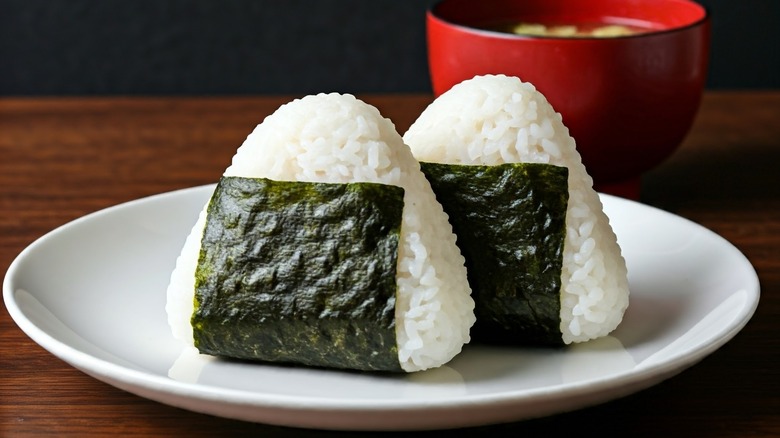What Really Separates Nigiri From Onigiri
Nigiri and onigiri are two staples in Japanese cuisine that may seem like they only differ in one letter, but they are entirely different in preparation and usage. Simply put, nigiri is a type of sushi that consists of a small vinegar rice ball (sushi rice or sticky rice) topped with a slice of raw seafood or fish. On the other hand, onigiri is a type of sushi that utilizes a salted rice ball (or a triangular shape wrapped in seaweed) filled with ingredients such as the Japanese seasoning blend furikake, mayo, and cooked fish — but raw fish is not typically used.
Unlike nigiri, which is eaten with chopsticks, onigiri is designed to be a handheld vessel. Furthermore, nigiri is often best represented in a fine-dining experience at Japanese restaurants, although you can find more affordable, though lesser quality, nigiri at marketplaces or even grocery stores. Onigiri is more of a casual, daily snack found at food carts and supermarkets, and often enjoyed on-the-go.
The long history of nigiri and onigiri
Nigiri and onigiri have a long-standing history in Japan. Nigiri was first made and prepared in Tokyo in the mid-19th century, and started as a popular street food — it was actually considered "fast food" back then. The invention of nigiri is credited to Japanese restauranteur and chef, Hanaya Yohei, referred to as the "Father of Nigiri." He opened the first sushi stall in Tokyo, and was known for a unique hand-pressing technique with rice, as well as using fresh fish.
Although sushi had been around long before Yohei, mainly as a method of preserving fish in rice, it was he who made the sushi-building process quicker and more simplified (originally, sushi was strictly crafted using wooden boxes). Although this ancient sushi started as an easy, on-the-go, street food option, the rise in popularity led to more experimentation with various kinds of ocean fish, leading to a more luxurious dish for more wealthy consumers.
As for onigiri, clumps of carbonized rice were found by archaeologists over 2000 years ago in Japan that shed more light on its history. Onigiri was originally served to court functionaries as a ritual gift exchange during the Heian period (794-1185). Once other ingredients started to be introduced, you could often find onigiri as a staple dish in the military during the Kamakura period (1192-1333). It wasn't until the Edo period (1603-1867) that it became a daily go-to for anyone in Japan. Now, you can find sushi carts full of onigiri and restaurants with fresh nigiri all around the world.
Making nigiri and onigiri at home
If you want to try making these Japanese staples at home, there are a few tips to keep in mind. First, forming both the nigiri and onigiri rice requires a careful technique of pressing the grains with wet hands, as to ensure that the rice does not stick to your hands. Also, with nigiri, it's imperative that the highest-quality, fresh fish is chosen (some of the most popular options include tuna, salmon, and crab). With onigiri — because of the more casual nature — the fish preparation can be more basic, and paired with the selected ingredients and seaweed. Both nigiri and onigiri are served perfectly with soy sauce, wasabi, ginger, etc.
A very common and simple-to-craft type of onigiri is musubi, a portable rice ball that's filled, mixed, or topped with various ingredients. Musubi is simple to make at home, mostly because the toppings can include ingredients such as Spam (popular in Hawaii), eggs, and furikake. For nigiri, you'll want to go to your local fish market and inquire about sushi-grade fish that is deemed suitable to consume raw. Both styles of sushi can be crafted with just your hands, or using a sushi rolling mat, which can help ensure tight sushi rolls, and be a great way to organize ingredients in the roll.



